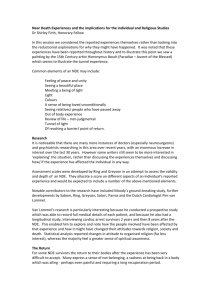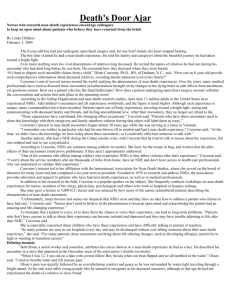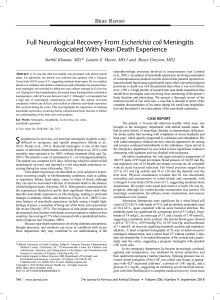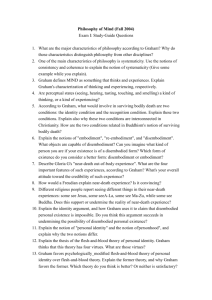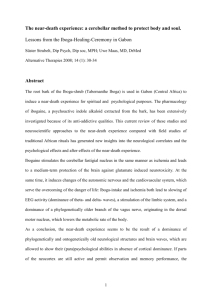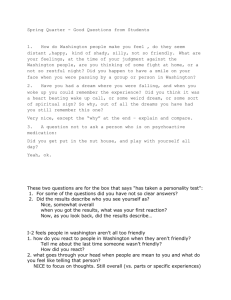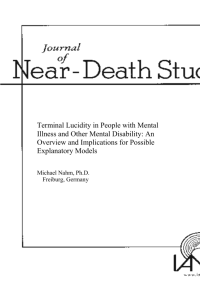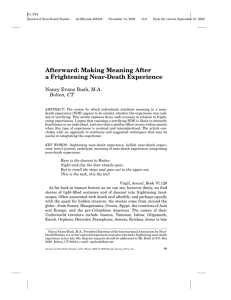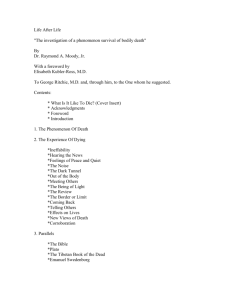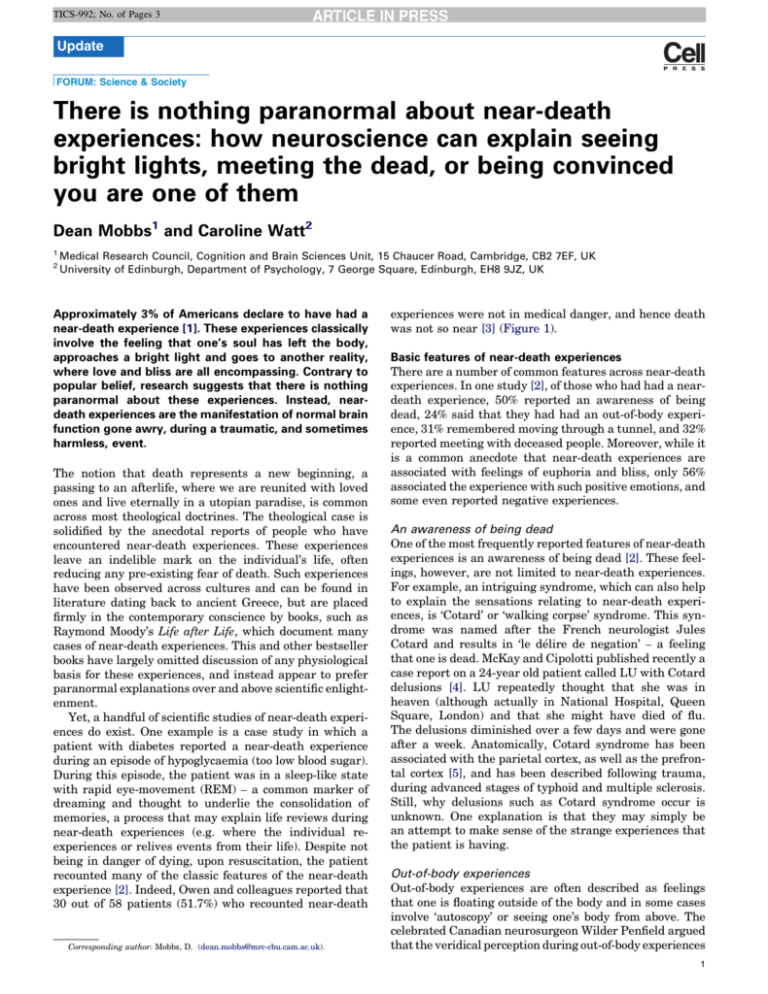
TICS-992; No. of Pages 3
Update
FORUM: Science & Society
There is nothing paranormal about near-death
experiences: how neuroscience can explain seeing
bright lights, meeting the dead, or being convinced
you are one of them
Dean Mobbs1 and Caroline Watt2
1
2
Medical Research Council, Cognition and Brain Sciences Unit, 15 Chaucer Road, Cambridge, CB2 7EF, UK
University of Edinburgh, Department of Psychology, 7 George Square, Edinburgh, EH8 9JZ, UK
Approximately 3% of Americans declare to have had a
near-death experience [1]. These experiences classically
involve the feeling that one’s soul has left the body,
approaches a bright light and goes to another reality,
where love and bliss are all encompassing. Contrary to
popular belief, research suggests that there is nothing
paranormal about these experiences. Instead, neardeath experiences are the manifestation of normal brain
function gone awry, during a traumatic, and sometimes
harmless, event.
The notion that death represents a new beginning, a
passing to an afterlife, where we are reunited with loved
ones and live eternally in a utopian paradise, is common
across most theological doctrines. The theological case is
solidified by the anecdotal reports of people who have
encountered near-death experiences. These experiences
leave an indelible mark on the individual’s life, often
reducing any pre-existing fear of death. Such experiences
have been observed across cultures and can be found in
literature dating back to ancient Greece, but are placed
firmly in the contemporary conscience by books, such as
Raymond Moody’s Life after Life, which document many
cases of near-death experiences. This and other bestseller
books have largely omitted discussion of any physiological
basis for these experiences, and instead appear to prefer
paranormal explanations over and above scientific enlightenment.
Yet, a handful of scientific studies of near-death experiences do exist. One example is a case study in which a
patient with diabetes reported a near-death experience
during an episode of hypoglycaemia (too low blood sugar).
During this episode, the patient was in a sleep-like state
with rapid eye-movement (REM) – a common marker of
dreaming and thought to underlie the consolidation of
memories, a process that may explain life reviews during
near-death experiences (e.g. where the individual reexperiences or relives events from their life). Despite not
being in danger of dying, upon resuscitation, the patient
recounted many of the classic features of the near-death
experience [2]. Indeed, Owen and colleagues reported that
30 out of 58 patients (51.7%) who recounted near-death
Corresponding author: Mobbs, D. (dean.mobbs@mrc-cbu.cam.ac.uk).
experiences were not in medical danger, and hence death
was not so near [3] (Figure 1).
Basic features of near-death experiences
There are a number of common features across near-death
experiences. In one study [2], of those who had had a neardeath experience, 50% reported an awareness of being
dead, 24% said that they had had an out-of-body experience, 31% remembered moving through a tunnel, and 32%
reported meeting with deceased people. Moreover, while it
is a common anecdote that near-death experiences are
associated with feelings of euphoria and bliss, only 56%
associated the experience with such positive emotions, and
some even reported negative experiences.
An awareness of being dead
One of the most frequently reported features of near-death
experiences is an awareness of being dead [2]. These feelings, however, are not limited to near-death experiences.
For example, an intriguing syndrome, which can also help
to explain the sensations relating to near-death experiences, is ‘Cotard’ or ‘walking corpse’ syndrome. This syndrome was named after the French neurologist Jules
Cotard and results in ‘le délire de negation’ – a feeling
that one is dead. McKay and Cipolotti published recently a
case report on a 24-year old patient called LU with Cotard
delusions [4]. LU repeatedly thought that she was in
heaven (although actually in National Hospital, Queen
Square, London) and that she might have died of flu.
The delusions diminished over a few days and were gone
after a week. Anatomically, Cotard syndrome has been
associated with the parietal cortex, as well as the prefrontal cortex [5], and has been described following trauma,
during advanced stages of typhoid and multiple sclerosis.
Still, why delusions such as Cotard syndrome occur is
unknown. One explanation is that they may simply be
an attempt to make sense of the strange experiences that
the patient is having.
Out-of-body experiences
Out-of-body experiences are often described as feelings
that one is floating outside of the body and in some cases
involve ‘autoscopy’ or seeing one’s body from above. The
celebrated Canadian neurosurgeon Wilder Penfield argued
that the veridical perception during out-of-body experiences
1
TICS-992; No. of Pages 3
Update
Trends in Cognitive Sciences xxx xxxx, Vol. xxx, No. x
100
90
80
Percentage
70
Key:
60
Report NDEs
50
Do not report NDEs
40
30
20
10
0
Prospective study of NDEs Retrospective study of NDEs
NDEs without danger
TRENDS in Cognitive Sciences
Figure 1. Large scale studies showing the number of people who report near-death experiences (NDEs). The far left bars show that a large proportion (82%) of near-death
survivors do not report near-death experiences [2]. The central bars represent a retrospective, or historic, study [15]. Crucially, the far right bars show that around half of the
people who reported near-death experiences in this study were not in danger of dying [3].
is brain-based. These experiences are also common during
interrupted sleep patterns that occur just prior to sleep or
waking. For example, sleep paralysis, which is a natural
part of REM sleep and results in paralysis when the person
is still aware of the external world, is reported in up to 40% of
the population and is associated with hypnagogia (i.e. vivid
dreamlike auditory, visual, or tactile hallucinations associated with the wake-sleep cycle), which can result in the
sensation of floating above one’s body [6]. Recently, Olaf
Blanke and colleagues demonstrated that out-of-body
experiences can be artificially induced by stimulating the
right temporoparietal junction [7]. Upon stimulation, the
patient would say things like ‘‘I see myself lying in bed. . .’’.
Other stimulations resulted in the patient feeling as if they
were ‘floating’. The authors of the study suggested that outof-body experiences result from a failure to integrate multisensory information from one’s body, which results in the
disruption of the phenomenological elements of self-representation.
A tunnel of light
Near-death experiences are also associated with the perception that one is moving down a dark tunnel and surfacing into a ‘world of light’. These experiences can also be
artificially induced: pilots flying at G-force can sometimes
experience a phenomenon known as hypotensive syncope,
which usually causes tunnel-like peripheral to central
visual loss to develop over 5-8 seconds [8]. Although in
the case of actual near-death experiences the mechanisms
are still unclear, a review by Nelson and colleagues suggested that the light at the end of the tunnel can be
explained by visual activity during retinal ischemia [9],
which occurs when the blood and oxygen supply to the eye
is depleted. A visual disorder, such as glaucoma, can also
2
result in loss of peripheral vision leading to tunnel vision.
Indeed, such tunnel vision is associated with extreme fear
and hypoxia (i.e. oxygen loss), two processes common to
dying. As Blackmore points out, the visual cortex is organized by cells that process peripheral and fovea (i.e. central) vision and excitation of the these cells will result in a
central bright light and dark periphery, that is, a tunnel
effect [10].
Meeting deceased people
Prevalent in fiction and celluloid is the notion that, when
we die, we are surrounded by the souls of the dead, angels
or a religious figure in a peaceful transcendental place.
Many neuroscientific studies have shown that brain pathology can lead to similar visions. For example, patients
with Alzheimer’s or progressive Parkinson’s disease can
have vivid hallucinations of ghosts or even monsters.
Patients have also been noted as seeing headless corpses
and dead relatives in the house, which has been linked to
pallidotomy lesions, suggesting that this result from abnormal dopamine functioning, a neurochemical that can
evoke hallucinations[11]. Intriguingly, electrical stimulation of the adjacent region of the angular gyrus can result
in a sense of presence (i.e. someone is standing behind
us[12]). Macular degeneration (i.e. damage to the center, or
macula, of the visual field) can also result in vivid visual
hallucinations of ghosts and fairytale characters. Such an
example is Charles-Bonnet syndrome, which mostly occurs
in the elderly populations. One theory is that hallucinations occur due to compensatory over-activation in brain
structures nearby the damaged area or making sense of
noise coming from the damaged areas. Thus, hallucinations might be derived from internal sources which are
appraised incorrectly.
TICS-992; No. of Pages 3
Update
Positive emotions
Another commonly reported feature of near-death experiences is a feeling of pure bliss, euphoria and an acceptance
of death. Many medicinal and recreational drugs, however,
can mirror the positive emotions and visions reported in
near-death experiences. At varying doses, the administration of ketamine can mimic these experiences including
hallucinations, out-of-body experiences, positive emotions
such as euphoria, dissociation, and spiritual experiences.
Ketamine is sometimes used as an anesthetic through its
binding with opioid mu- receptors and hallucinations may
occur through inhibiting N-methyl-D-aspartate (NMDA)
receptors, the same receptors that are evoked during the
administration of recreational drugs like amphetamine.
Thus, the neurochemical processes that ketamine evokes
may be similar to some of the positive emotional experiences and visions during near-death experiences, through
evoking the rewarding properties of the opioid system and
misattribution of events due to disruption of the prefrontal
cortex [13]. Such processes may occur naturally and similar systems are evoked when animals are under extreme
danger. For example, dopamine and opioid systems become
active when an animal is under predatory attack. Thus,
these endogenous systems come into play during highly
traumatic events and have likely evolved to aid in the
survival of the organism.
Understanding the neurobiological mechanisms of
near-death experiences
The near-death experience is a complex set of phenomena
and a single account will not capture all its components.
One recent theory is that the basic arousal systems beginning in the midbrain may account for many of the components of the near-death experience [10]. Of interest is the
locus coeruleus, a midbrain region involved in the release
of noradrenaline. Noradrenaline is known to be involved in
arousal related to fear, stress, and hypercarbia [10], and is
highly connected to regions that mediate emotion and
memory, including the amygdala and hippocampus. Indeed, stimulation of the noradrenaline system has been
shown to enhance and consolidate memory, and plays a
critical role in the sleep-wake cycle, including REM sleep.
Along with basic midbrain systems, such as the periaqueductal gray, a region involved in opioid analgesia and basic
fear responses, and the ventral tegmental area, which is a
core dopamine reward area, the noradrenaline system may
be part of a basic set of systems that directly or indirectly
evoke positive emotions, hallucinations and other features
of the near-death experience.
Taken together, the scientific evidence suggests that all
aspects of the near-death experience have a neurophysiological or psychological basis: the vivid pleasure frequently
experienced in near-death experiences may be the result of
fear-elicited opioid release, while the life review and REM
Trends in Cognitive Sciences xxx xxxx, Vol. xxx, No. x
components of the near-death experience could be attributed to the action of the locus coeruleus- noradrenaline
system. Out-of-body experiences and feelings of disconnection with the physical body could arise because of a breakdown in multisensory processes, and the bright lights and
tunneling could be the result of a peripheral to fovea
breakdown of the visual system through oxygen deprivation. A priori expectations, where the individual makes
sense of the situation by believing they will experience the
archetypal near-death experience package, may also play a
crucial role [14]. If one challenge of science is to demystify
the world, then research should begin to test these and
other hypotheses. Only then will discussion of near-death
experiences move beyond theological dialogue and into the
lawful realm of empirical neurobiology.
Acknowledgements
We wish to thank Chris Frith, Bernhard Staresina, Donna Harris and
Michael Ewbank for helpful comments. The paper was supported by the
UK Medical Research Council.
References
1 Schmied, I. et al. (1999) Todesnäheerfahrungen in Ost- und
Westdeutschland – eine empirische Untersuchung. In Todesnähe:
interdisziplinäre Zugänge zu einem außergewöhnlichen Phänomen
(Knoblaub, H. and Soeffner, H.G., eds), pp. 217–250, Universitätsverlag
Konstanz
2 van Lommel, P. et al. (2001) Near-Death experiences in surviviors of
cardiac arrest: a prospective study in the Netherlands. Lancet 358,
2039–2045
3 Owens, J.E. et al. (1990) Features of near-death experiences in relation
to whether or not the patients were near death. Lancet 336, 1175–1177
4 McKay, R. and Cipolotti, L. (2007) Attributional style in a case of
Cotard delusion. Conscious. Cogn. 16, 349–359
5 Feinberg, T.E. and Keenan, J.P. (2005) Where in the brain is the self?
Conscious. Cogn. 14, 661–678
6 Cheyne, J.A. and Girard, T.A. (2009) The body unbound: Vestibularmotor hallucinations and out-of-body experiences. Cortex 45, 201–215
7 Blanke, O. and Arzy, S. (2004) The out-of-body experience: disturbed
self-processing at the temporo-parietal junction. Neuroscientist 11,
16–24
8 Lambert, E.H. and Wood, E.H. (1946) Direct determination of man’s
blood pressure on the human centrifuge during positive acceleration.
Federation Proc. 5, 59
9 Nelson, K.R. et al. (2007) Out-of-body experience and arousal.
Neurology 68, 794–795
10 Blackmore, S.J. and Troscianko, T. (1988) The Physiology of the
Tunnel. J. Near Death Stud. 8, 15–28
11 Manford, M. and Andermann, F. (1998) Complex visual hallucinations:
Clinical and neurobiological insights. Brain 121, 1819–1840
12 Blanke, O. et al. (2002) Stimulating illusory own-body perceptions.
Nature 419, 269–270
13 Liao, Y. et al. (2011) Reduced dorsal prefrontal gray matter after
chronic ketamine use. Biol. Psychiatry 69, 42–48
14 Blackmore, S.J. (1993) Dying to live: Science and the near-death
experience, Grafton
15 Ring, K. (1980) Life at death: a scientific investigation of the near-death
experience, Coward McCann and Geoghenan
1364-6613/$ – see front matter ß 2011 Elsevier Ltd. All rights reserved.
doi:10.1016/j.tics.2011.07.010 Trends in Cognitive Sciences xx (2011) 1–3
3

